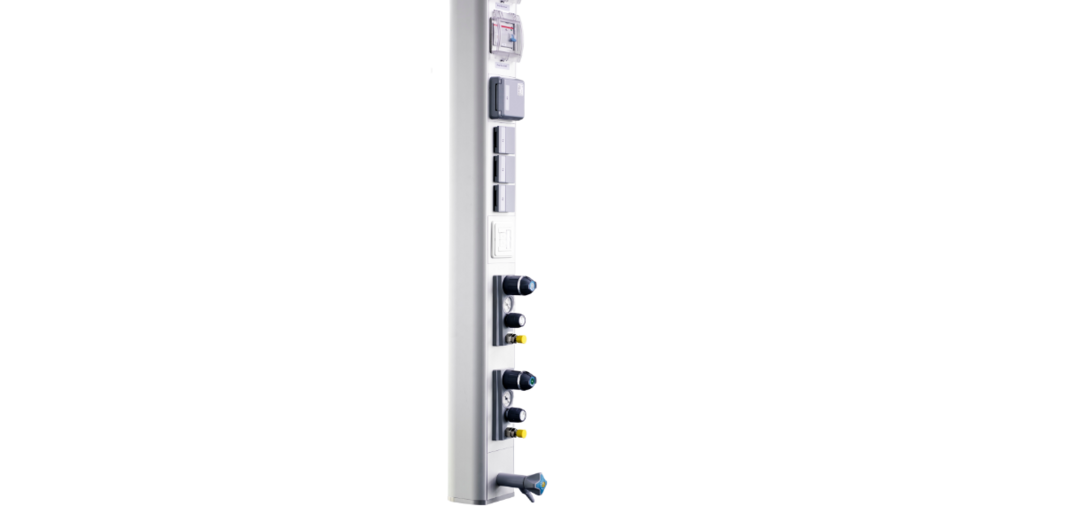A supporting column - for convertible laboratories
The cycles of use of laboratories are becoming shorter and shorter. Convertible room components can play a decisive role in flexible repurposing and contribute to sustainability thanks to resource conservation and recycling. Exactly the right incentive for our Waldner team to develop a new generation of service columns. A look behind the scenes.
For a moment, you might think that an infusion stand is pushing its way through the laboratory. But what is rolling so smoothly toward us is the new Waldner service column. The fact that it can be mounted on a stand and moved to wherever it is needed at any time is just one feature that makes the new column even more flexible than its predecessor generation. And more multipurpose, especially on closer inspection. "Because when we take a new approach to a product, we do it right, which for us means that we think it through holistically to the end according to the latest state of knowledge," says Moriz Walter, Head of Product Management at Laboreinrichtungen, summarizing the approach common at Waldner.
Designed by people for people
This time, the development process for the service column at Waldner was primarily handled by the tinkerers at Dimensions, who, as the specialist department for technical infrastructure in the room, are already proven specialists for this product line. The multidisciplinary development team for the new service column was formed around their expertise. "Deliberately all people who work with the column in practice and know exactly the customer requirements for it and help shape it," says Moriz Walter, describing the charm of his Waldner project team, for which he was responsible and coordinated as Head of Product Management, Research and Development.
An idea is born - and quickly becomes a success
The first prototype was created in the fall of 2019, and although the new service column already celebrated a relatively large proof at the University of Michigan in the late summer of 2020, the development team involved today looks back rather modestly. "Internally, there were always impulses," says Matthias Schmid, specialist team leader of Waldner's Dimensions division and co-developer of the new column variant, about the idea of trying something new in this direction. However, the decisive impetus came from the market. "There were one or two customers who placed a lot of value on great, slim, forward-looking design," Schmid continues. Working with them, he says, the desire for visually appealing solutions and a harmonious sense of space emerged more and more. "The previous columns were too edgy, too angular, too massive, too heavy. The mobile laboratory should be light, airy and open," Matthias Schmid formulates the expectations of architects, planners and laboratory operators. Until now, however, the service column had been designed purely for function, since it originally arose from the concrete needs of the users. But how do you change such well-rehearsed patterns in such a short time? Schmid's answer to this question sounds as logical as it is simple: "We took over everything that the old column could do one-to-one, weeded out the suboptimal, added the new requirements and then put the whole thing in a stylish coat. The result is the service column 2.0, which combines maximum changeable function and aesthetic design in equal measure, and which is no longer used only in classic applications.
The new service column - as flexible as desired
The very fact that the column has become lighter and slimmer overall makes it more variable in use in the laboratory. Even two columns back to back in one rail are possible. The real highlight, however, is its head plate with combined suspension bracket, which can be clicked into the ceiling profile like an umbrella handle and thus serves as a drop guard and sliding element for the new "simply mount". Simply slide or hook it into place where the media column is needed at the moment, briefly screw it into place at four points, and you're done. In contrast to the previous model, ceiling mounting can now be carried out by one person alone and without tools in just 5 (instead of 15) minutes. In laboratories with up to 16 service columns per 100 square meters, this quickly saves several working hours. As before, the new service column can be permanently installed, alternatively mounted on the wall or - and this is new - moved back and forth between rooms and workstations on rollers like a kind of infusion stand. Quick-connect plugs enable direct connection to sockets, gas and water pipes, which (in the case of Dimensions) are located in the infrastructure on the ceiling. The new generation of columns also allows aestheticians more room to maneuver in a project, as they often find their slim, semi-circular design and the absence of visually visible joints and screws more harmonious.
Only flexible adaptation makes you fit for the future
2022: The new service column has arrived - in production and on the market. But we are not finished yet! There are still more ideas in our heads about what else this versatile room component could do.
The more versatile and faster a component reacts to changing needs and can adapt intelligently, the more successful it is in an evolutionary sense. The same can be assumed for a system like the changeable laboratory, which is likely to outlive many less flexible solutions in the long term in the "survival of the fittest". After all, with ever-shorter cycles, conversion costs are becoming one of the deciding factors in a lab's lifetime costs.

23. February 2023 um 02:28
Hi waldner.de administrator, Good to see your posts!